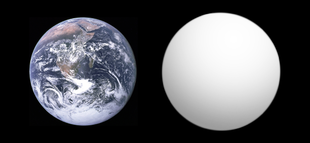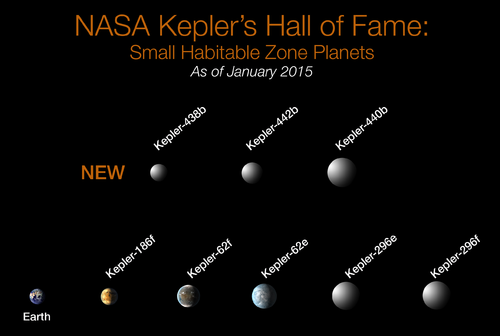Kepler-438b
|
Exoplanet Kepler-438 b |
|
|---|---|
| Approximate size of Kepler-438b (right) compared to Earth | |
| Constellation | lyre |
| Position equinox : J2000.0 |
|
| Right ascension | 18h 46m 35.0000s |
| declination | + 41 ° 57 ′ 03.93 ″ |
| Orbit data | |
| Central star | Kepler-438 |
| Major semi-axis | 0.166 AU |
| eccentricity | 0.03 +0.01−0.03 |
| Period of circulation | 35.23319 ± 0.00029 d |
| Further data | |
| radius | 1.120 |
| distance | 145 pc |
| history | |
| Date of discovery | 2015 |
| Catalog names | |
| KOI-3284.01, Kepler-438 b, KOI-3284 b, K03284.01, WISE J184634.98 + 415704.0 b, KIC 6497146 b, 2MASS J18463499 + 4157039 b | |
Kepler-438b (also KOI-3284.01 ) is a confirmed and almost Earth-sized exoplanet , very likely a rocky planet , orbiting the red dwarf Kepler-438 in the constellation Lyra in its habitable zone . The planet was prepared by the space telescope Kepler the NASA using the Transit method discovered, the slight darkening of the star is measured in the pass of the planet. NASA announced the confirmation of the exoplanet on January 6, 2015.
Confirmed exoplanet
Kepler-438b is an exoplanet nearly the size of Earth with 1.12 Earth radii . The planet orbits the red dwarf star Kepler-438, which is much smaller and cooler than the sun , in 35.2 days.
Habitability
The planet is in the habitable zone of Kepler-438, where liquid water could exist on its surface. When its discovery was announced, Kepler-438b was named one of the most Earth-like planets in terms of its size and temperature that had been found by then. The surface temperature is estimated, for example, at 276 Kelvin or 3 ° C (calculated as the equilibrium temperature with an assumed bond albedo of the earth of 255 K. The actual temperature should be even higher, depending on the unknown atmosphere, because the mean temperature on the earth's surface is 288 K or 15 ° C instead of 255 K due to the bond albedo).
See also
Individual evidence
- ↑ Guillermo Torres, David M. Kipping, Francois Fressin, Douglas A. Caldwell, Joseph D. Twicken, Sarah Ballard, Natalie M. Batalha, Stephen T. Bryson, David R. Ciardi, Christopher E. Henze, Steve B. Howell, Howard T. Isaacson, Jon M. Jenkins, Philip S. Muirhead, Elisabeth R. Newton, Erik A. Petigura, Thomas Barclay, William J. Borucki, Justin R. Crepp, Mark E. Everett, Elliott P. Horch, Andrew W Howard, Rea Kolbl, Geoffrey W. Marcy, Sean McCauliff, Elisa V. Quintana: Validation of Twelve Small Kepler Transiting Planets in the Habitable Zone . arxiv : 1501.01101 .
- ↑ a b c d e Jet Propulsion Laboratory: NASA's Kepler Marks 1,000th Exoplanet Discovery, Uncovers More Small Worlds in Habitable Zones. Retrieved April 7, 2015 .
- ↑ a b c d The Guardian: Kepler 438b: Most Earth-like planet ever discovered could be home for alien life. Retrieved April 7, 2015 .
- ^ The Extrasolar Planet Encyclopaedia: Planet Kepler-438 b. Retrieved April 7, 2015 .
- ↑ a b Paul Gilster: AAS: 8 New Planets in Habitable Zone. Retrieved April 7, 2015 .
Web links
- National Astronautics and Space Administration: Kepler Mission. Retrieved April 7, 2015 . (English)
- National Astronautics and Space Administration: Kepler Discoveries. Retrieved April 7, 2015 . (English)
- National Astronautics and Space Administration: NASA Exoplanet Archive. Retrieved April 7, 2015 . (English)
- The Extrasolar Planet Encyclopaedia: Planet Kepler-438 b. Retrieved April 7, 2015 . (English)
- Planetary Hability Laboratory, University of Puerto Rico: Habitable Exoplanets Catalog. Retrieved April 7, 2015 . (English)


